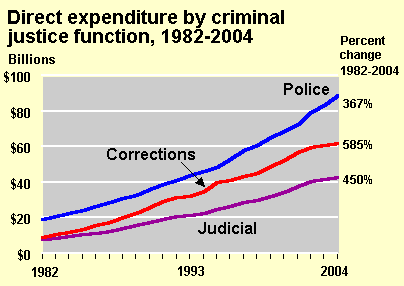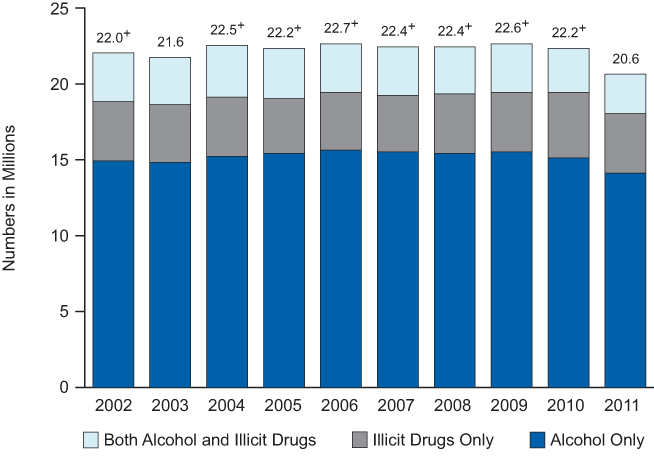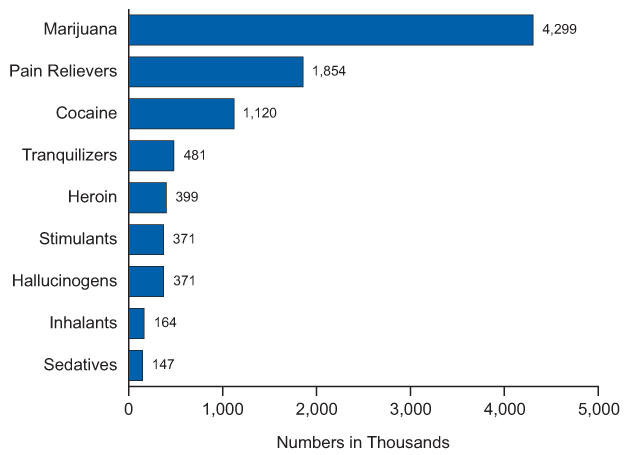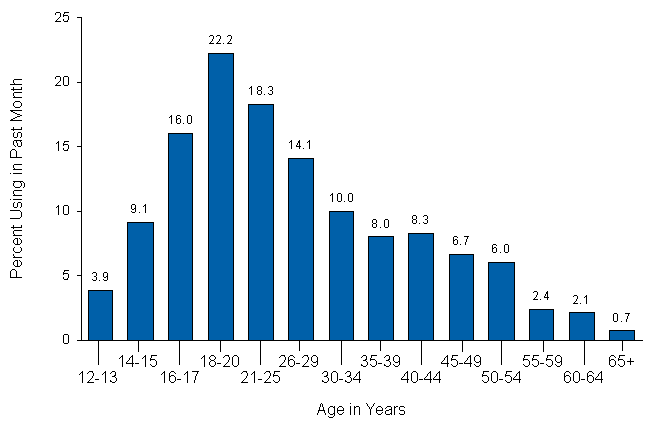Most Further Use Is Controlled
Dependence (Addiction) Is An Uncommon Result
The majority of those who have ever used an illicit drug report using ten or fewer times in their lifetimes.
Even the vast majority of those who use an illicit drug more than 10 times will voluntarily stop before using that drug 200 times in their entire lives.
Use of a drug more than 200 times in a lifetime does not define dependence.
"... we know that dependence is relatively uncommon among typical human users (10% is a typical upper bound figure)." [a]
# times |
Marijuana |
Cocaine |
Stimulants |
1 or 2 |
27 % |
25 % |
16 % |
3 to 5 |
14 % |
17 % |
16 % |
6 to 10 |
13 % |
15 % |
15 % |
*1 to 10 totals |
54 % |
57 % |
47 % |
11 to 49 |
14 % |
18 % |
21 % |
50 to 99 |
9 % |
10 % |
9 % |
100-199 |
5 % |
6 % |
8 % |
** % late stops |
61 % |
79 % |
72 % |
200 + |
18 % |
9 % |
15 % |
* Percent of users who tried a particular drug but never used it more than 10 times in their lives.
** Percent of users who used a particular drug more than 10 times in their lives but stopped before using it 200 times.
All figures are for age 25 and older.
(Methamphetamine is a typical "Stimulant")
Data from NHSDA, 1993 is cited by The Drug Policy Project of the Federation of American Scientists. FAS, Issue 3, "How Prevalent Are 'Very Light' Drug Users?" by Jonathan Caulkins http://www.fas.org/drugs/issue3.htm#2
[a] FAS, Issue 4, "In What Sense (If Any) Is Marijuana A Gateway Drug ?" by Robert MacCoun http://www.fas.org/drugs/issue4.htm#politics
X.2 - Compare Addictive Properties of 6 Common Drugs, NIDA
Two Independent Studies Of Drug Addiction: Henningfield, National Institute on Drug Abuse, and Benowitz [B], University of California at San Francisco, Ratings [Lowest number = most serious effect]
Withdrawal |
Reinforcement |
Tolerance |
Dependence |
Intoxification |
|
Heroin |
2 |
2 |
1 |
2 |
2 |
B |
2 |
2 |
2 |
2 |
2 |
Alcohol |
1 |
3 |
3 |
4 |
1 |
B |
1 |
3 |
4* |
4 |
1 |
Cocaine |
4 |
1 |
4 |
3 |
3 |
B |
3* |
1 |
1 |
3 |
3 |
Nicotine |
3 |
4 |
2 |
1 |
5 |
B |
3* |
4 |
4* |
1 |
6 |
Caffeine |
5 |
6 |
5 |
5 |
6 |
B |
[5] |
5 |
3 |
5 |
5 |
Marijuana |
6 |
5 |
6 |
6 |
4 |
B |
[6] |
6 |
[6] |
6 |
4 |
* = shared rank with another listed drug
[#] = ranking adjusted by DPFT to reflect lower shared rankings
DPFT Note: Other than some variations in the tolerance rankings, the two studies produced virtually identical results. The studies were cited in presentations to the Senate-House Task Force on National Drug Policy in 1996.
Withdrawal: Presence and severity of characteristic withdrawal symptoms.
Reinforcement: A measure of the substance's ability, in human and animal tests, to get users to take it again and again, and in preference to other substances.
Tolerance: How much of the substance is needed to satisfy increasing cravings for it, and the level of stable need that is eventually reached.
Dependence: How difficult it is for the user to quit, the relapse rate, the percentage of people who eventually become dependent, the rating users give their own need for the substance and the degree to which the substance will be used in the face of evidence that it causes harm.
Intoxication: Though not usually counted as a measure of addiction in itself, the level of intoxication is associated with addiction and increases the personal and social damage a substance may do.
[3]
Abuse and dependence are highly dependent on age. The teen years are critical. National Survey on Drug Use and Health (NSDUH). Data for 2005 :
Age Group |
Percent A or D |
12 to 17 |
8.0 % |
18 to 25 |
21.8 % |
26 or older |
7.1 % |
NSDUH 2010
Age Group |
Percent A or D |
12 to 17 |
7.3 % |
18 to 25 |
19.8 % |
26 or older |
7.0 % |
Addiction, says Dr. Mark Willenbring, director of Treatment and Recovery Research at the National Institute on Alcohol Abuse and Alcoholism, "is a disorder of young people." The vast majority of people who suffer from addiction encountered the beginnings of their illness when they were teenagers. Ninety-five percent of people who are dependent on alcohol or other drugs started before they were 20 years old.
- from Addiction Among Adolescents.

Source: Justice Expenditure and Employment Extracts
[4]
Drug Use By Age
Most Drug Use Begins With Teen Curiosity
Drug Use Peaks Around Age 20
Drug Use Declines Greatly By Age 25 to 35
Percentage of use by different age groups
Any Illicit Drug Use Other Than Marijuana (Derived from Table 1.27B, National Survey on Drug Use and Health (NSDUH) 2003
Age |
Current Use (last month) |
13 |
4 % |
15-16 |
7 % |
20 |
11 % |
26 - 29 |
6 % |
30 - 34 |
4 % |
Cocaine offers a typical example. These figures include crack cocaine.
Cocaine Use in 2003 by Age (Table 1.21B, NSDUH)
Age |
Current Use (% used in last month) |
14 |
0.03 % % |
15 |
0.07 % |
22 [peak year] |
2.6 % |
26 - 29 |
1.8 % |
30 - 34 |
1.3 % |
40 - 45 |
0.07 % |
DPFT: Drug policy seems misguided in squandering resources on adults who have already chosen to break the law and use illicit drugs but who are in the process of giving them up voluntarily.
X.3 - Lancet panel ranks drugs by danger
"Development of a rational scale to assess the harm of drugs of potential misuse"
Lancet - Vol 369 March 24, 2007 Health Policy www.thelancet.com
Authors comments (extracts)
Authors: David Nutt, Leslie A King, William Saulsbury, Colin Blakemore
Group A (Group B rank) |
Group B |
1 (1) = heroin |
1=Heroin |
2 (2) = cocaine |
2=Cocaine |
3 (5) = alcohol |
3= Barbiturates |
4 (3) = barbiturates |
4=Street methadone |
5 (8) = amphetamine |
5 = Alcohol |
6 (4)= methadone |
6 = Ketamine [a] |
7 (7)= benzodiazepines |
7 = Benzodiazepines |
8 (12) = solvents. |
8 = Amphetamine |
9 (10) = buprenorphine |
9 = Tobacco |
10(9) = tobacco |
10=Buprenorphine |
11 (18)= ecstasy |
11 = Cannabis |
12 (11) = cannabis |
12 = Solvents |
13 (14) = LSD |
13 = 4-MTA [a] |
14 (16) = steroids |
14 = LSD |
15/Methylphenidate |
|
16/Anabolic steroids |
|
17/GHB |
|
18/Ecstasy |
|
19/Alkyl nitrates |
|
20/Khat |
[a] Only Ketamine and 4-MTA were ranked among the 14 most dangerous drugs by group B but not by group A.
The ranking considered nine different factors. Though it is very difficult to rank drugs, the final results were quite similar. They also closely parallel other scientific findings :
[b] The expert groups were contacted by Lancet. Their comments below refer to laws in the UK but they apply equally to the US. Like most analysts they fear that the current system undermines a critical line of defense, the credibility of drug education. Part of this is the skewed emphasis on illegal drugs rather than equally or , more dangerous legal drugs, notably, alcohol.
Authors comments (extracts)
"Drug misuse and abuse are major health problems. Harmful drugs are regulated according to classification systems that purport to relate to the harms and risks of each drug. However, the methodology and processes underlying classification systems are generally neither specified nor transparent, which reduces confidence in their accuracy and undermines health education messages.
"Current approaches to counter drug misuse are interdiction of supply (via policing and customs control), education, and treatment. All three demand clarity in terms of the relative risks and harms that drugs engender.
"The current classification system has evolved in an unsystematic way from somewhat arbitrary foundations with seemingly little scientific basis.
"These estimates suggest that smoked tobacco is the most addictive commonly used drug, with heroin and alcohol somewhat less so; psychedelics have a low addictive propensity.
"Tobacco is estimated to cause up to 40% of all hospital illness and 60% of drug-related fatalities. Alcohol is involved in over half of all visits to accident and emergency departments and orthopaedic admissions. [12] However, these drugs also generate tax revenue that can offset their health costs to some extent.
"Tobacco and alcohol together account for about 90% of all drug-related deaths in the UK.
"We saw no clear distinction between socially acceptable and illicit substances. The fact that the two most widely used legal drugs lie in the upper half of the ranking of harm is surely important information that should be taken into account in public debate on illegal drug use.
"Discussions based on a formal assessment of harm rather than on prejudice and assumptions might help society to engage in a more rational debate about the relative risks and harms of drugs.
"We believe that a system of classification like ours, based on the scoring of harms by experts, on the basis of scientific evidence, has much to commend it.
"This system is able to respond to evolving evidence about the potential harm of current drugs and to rank the threat presented by any new street drug.
[c ] Authors
Psychopharmacology Unit, University of Bristol, Bristol, UK (Prof D Nutt FMedSci);
Forensic Science Service, London, UK (L A King PhD)
Police Foundation, London (W Saulsbury MA)
Medical Research Council, London (Prof C Blakemore FRS)
Department of Physiology, Anatomy and Genetics, Oxford, UK (Prof C Blakemore)
Correspondence to:
Prof David Nutt, Psychopharmacology Unit, University of Bristol,
BristolBS1
3NY, UK
david. j. nutt@bristol. ac. uk
X.4 - French National Institute of Health Ranks Drugs By Danger
The French National Institute of Health, INSERM, consulted with experts from other countries and rated drugs by their danger in 1998 at government request.
They established 3 groups:
[A] "most dangerous" - heroin, alcohol, and cocaine
[B] "next most dangerous" - tobacco, amphetamines, and others
[C] "least dangerous" - cannabis [marijuana], since it has "low toxicity, little addictive power and poses only a minor threat to social behavior," and others
-- from "Alcohol as bad as heroin and worse than pot," Reuters, 6-16-98
X.5 - Addiction: What Drug - What Race - What Age
Data is from SAMHSA/OAS for the year 2002. All figures are government estimates. The figures do not include nicotine.
An estimated 22.0 million Americans in 2002 were classified with substance dependence or abuse (9.4 percent of the total population aged 12 or older).
Substance "dependence" is commonly called addiction.
Substance "abuse" refers to serious problematic use - not ordinary use - and does not include dependence.
Substance dependence or abuse are combined and the numbers are about equally divided between the two.
"Illicit drugs" includes prescription drug dependence or abuse
Alcohol addiction and abuse dominates the figures. Alcohol is the only drug involved in 68% of the cases and is heavily involved in another 15% for a total of 83%, or 5 out of every 6 major drug problems.
mn = million
Substance Dependence or Abuse
Alcohol only |
14.9 mn |
Alcohol and illicit drugs |
3.2 mn |
Illicit drugs only |
3.9 mn |
Total |
22.0 mn |
Race
Rates of substance dependence or abuse (among persons aged 12 or older in 2002) by 3 racial groups:
White |
9.3 percent |
Black |
9.5 percent |
Hispanic |
10.4 percent |
AGE Rates of substance dependence or abuse by age group:
12 to 17 |
8.9 percent |
18 to 25 |
21.7 percent |
26 or older |
7.3 percent |
Illicit Drugs
See Chart 2 for a comparison of the addictive qualities of 6 common drugs: alcohol, heroin, cocaine, marijuana, caffeine and nicotine
Figures for individual drugs can't be added to find total users. Many users use multiple drugs so the total number of users is much smaller than addition would indicate.
Marijuana
Of the 7.1 million Americans classified with dependence on or abuse of illicit drugs, 4.3 million were dependent on or abused marijuana.
For many reasons, a better picture might exclude marijuana from this section. Many - especially teens - who apply for treatment may do so under threat of punishment from courts or schools - or possibly parents - if they do not. Rates of teenage marijuana abuse seem to be much higher in the US than in other countries and coercion may account for the wide disparity. It is also widely understood that marijuana dependence or abuse is generally much less severe and more easily treated than with other drugs.
There is anecdotal evidence of people who find it helpful to end uncontrolled use of other drugs through controlled use of marijuana. The illegal status of marijuana has made valid research into this a virtual impossibility.
Cocaine
Cocaine accounted for 1.5 million persons. (This is about 1/10 the figure for alcohol. The number includes crack which is believed to account for about 1/4 of the figure.)
Heroin
Government estimates [NSDUH] regularly report only about 150,000 problematic heroin users or 1/10 the figure for cocaine. This is probably a serious underestimation - due to unique research limitations - of the number involved which may easily be from 3 to 5 times greater. But even a much larger number is still very small in relative terms.
NSDUH also reports that non-medical use of pain relievers accounted for 1.5 million cases of dependence or abuse in 2002. This can be very similar to heroin dependence or abuse.
Employment
Of the 19.8 million adults (18 or older) classified with dependence or abuse, 15.3 million (77.1 percent) were employed.

Substance Dependence or Abuse in the Past Year among Persons Aged 12 or Older: 2002-2009

About half of "ILLICIT DRUGS" is abuse of prescription drugs. See notes 1 and 2
Dependence on or Abuse of Specific Illicit Drugs in the Past Year among Persons Aged 12 or Older: 2007


